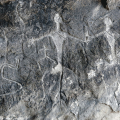OPEN-AIR MUSEUM OF GOBUSTAN
Go there and contact
Museum in a stunning mountain setting, offering tours to discover the various caves
The site is located in an astonishing mountain, istrian in the middle of a flat desert. In the distance, a élévation elevation, Alice Rocks, was inhabited by tribes of fishermen and hunters of the age of the stone age. The tropical climate, fed by the Caspian Sea, lick the foot of the mountain, facilitated the lives of these ancient tribes. But about 8 000 years ago, an earthquake caused the collapse of the mountain, forcing local populations to migrate to Qobustan site. The latter, inhabited up to the age of bronze, has preserved numerous paintings and carvings, depicting the daily life and religious rites of its inhabitants at different times.
At the entrance to the first cave, you can see a buffalo carved in the rock. As a result of climate change, buffalo have disappeared from the Qobustan region for about 4 000 years. A symbol of prosperity, this animal is often represented on paintings and cave engravings. Just above the buffalo is a little reindeer dating from the bronze age and symbolizing beauty.
At the top left of the cave entrance, dancers of the stone age perform the movements of the fertility dance. At the bottom, a shaman is represented in a meditation position, surrounded by hunters and reindeer. On the side, hunters with bows and arrows, all dating from the stone age. A zigzag on the head of one of the hunters indicates the rain.
Over the hunter, you can see a boat with 23 features with so many rowers. This engraving allowed some historians to attribute to Qobustan inhabitants the invention of the first vessels.
Inside this first cave, women's representations are extremely stylized, however, with an increase in chest and hips, symbols of motherhood. The back of a buffalo connects to a woman's hips, illustrating the symbolic link between fertility and the totem animal of local populations.
The Mother's cave is a little further away in the mountain. Here the engravings stretch on nine levels, illustrating the longevity of the site's human settlements. This completely engraved set was created by an earthquake that made it possible to release the rocks that obstruaient the entrance. Internal strata were revealed by excavations of researchers. Herds of buffalo adorn the top of the wall, while a little lower is represented a man with a horse (horses were domesticated 2 000 years BC). The red line below this group of engravings comes from the ashes of a very ancient home, where tropical timber has been identified, so abundant in the region.
At the exit of the cave, a natural cliff is ahead of the vacuum. The holes dug in the stone were used to recover the blood of the animals offered for sacrifice. Other, larger holes were intended to harvest rain water or were used to cook. The great horizontal stone of a hole similar to the eye of a needle is superstitieusement dedicated to young women: those whose marriage is unfortunate have only to spend three times in the hole so that their wishes can be fulfilled.
The Buffles cave is adorned with the representation of a buffalo pushing rocks, resulting in a sinking of a boat. The buffalo was well regarded as a god, entitled to life and death on humans. On his left, two women are dancing: these are the only representations of women with arms.
The tribe of hunters opens onto the image of two domestic cows, with a rope around the neck. Horses, dancers and battlegrounds are also represented. The entrance is decorated with a tenderloin carved in the rock and contains the weapon that allows men to capture animals. It can be assumed that the catch was not assured, and that is precisely what these magic images were used for: by representing a happy hunt, the inhabitants of Qobustan wanted to promote their wish.
The site has a total of caves, but only those we mention are visited in tourist tours, most of which are connected by underground tunnels and labyrinths. You can visit more by making a specific request to your local travel guide or agency. The landscape that can be admired since the entrance of the caves is very photogenic, with its colored meadows pretending to belong to the desert.
Did you know? This review was written by our professional authors.
Book the Best Activities with Get Your Guide
Members' reviews on OPEN-AIR MUSEUM OF GOBUSTAN
The ratings and reviews below reflect the subjective opinions of members and not the opinion of The Little Witty.
